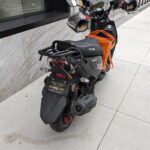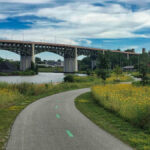Thinking about getting into triathlons but wincing at the price of a brand new bike? You’re not alone! Many triathletes, even seasoned ones, know the secret to saving big bucks: 2nd Hand Tri Bikes. Forget the pressure from bike “experts” who say you need the latest model. Let’s dive into how you can score an amazing deal on a used bike that’s perfect for your triathlon journey. We’re bargain hunters here, and a smart buy on a second hand bike can free up your budget for other essential gear – or race entry fees! Just like my own road and time trial bikes, buying used is a savvy move.
Why Go 2nd Hand for Your Tri Bike?
There are some seriously good reasons to consider a 2nd hand road bike as your triathlon companion:
- Triathlon Try-Out: New to triathlon and not sure if you’ll catch the bug? Dumping a ton of cash on a brand new, triathlon-specific bike is a risky move. A 2nd hand road bike lets you test the waters without the financial plunge. You’ll get a solid bike for training, and you can easily add clip-on aerobars to get that tri position and speed for races. If triathlon isn’t your thing, you’re still left with a great bike for recreational rides.
- Preserve Your Race Machine: Got a high-end triathlon or time trial bike for races? Keep it pristine! A 2nd hand road bike makes an ideal training partner. It’s perfect for logging miles without wearing out your race bike, and often more comfortable and safer for group rides and hilly routes.
Finding Your Size – No Expert Needed (Mostly)
Bike experts might gasp, but finding your exact frame size on the used market isn’t crucial to the millimeter. A slight size variation of +/- 2cm is usually workable. A good bike fitter can adjust the seat and stem to dial in your position. However, starting close is always better. Use a road bike size chart as a general guide to get in the ballpark.
Where to Hunt for 2nd Hand Tri Bikes
Time to hit the online marketplaces! Craigslist and Facebook Marketplace are your goldmines for finding 2nd hand tri bikes and road bikes. Steer clear of specialized bike sites for now – you’re more likely to encounter knowledgeable sellers (and less likely to snag a bargain). Remember, we’re aiming to be the smart buyers here.
Search for “bike [your frame size]cm” on these sites. Set a minimum price around $400 to filter out very low-end bikes. Browse the listings, and pick a few bikes that catch your eye – color matters if you’re particular!
Once you have some prospects, note down the brand, model name, and year (if listed). Now head over to the Bicycle Blue Book website and use their Value Guide. Enter the bike details (e.g., “2020 Specialized Allez Sport”) to see its estimated value. This is your cheat sheet to know if you’re getting a fair deal or being overcharged.
Ask the Seller the Right Questions
Reach out to the seller and ask some key questions if the listing doesn’t cover these points. They might not know everything, but you’ll get a sense of their bike history. Good questions include:
- Are the components original?
- How much has the bike been ridden?
- What year is it (or best guess)?
- Any frame damage like cracks or dents (if not visible in photos)?
Don’t be instantly put off if components aren’t original, especially on older bikes. Upgrades to parts like the drivetrain or wheels can actually increase the bike’s value. A quick Google search of the components can help you assess if these are genuine improvements.
Test Ride is Key
If a bike looks promising and the price seems right, schedule a viewing and test ride. Bring an allen key set and a pedal wrench so you can install your own pedals and shoes if you have them. You don’t need to be a bike expert to test ride! Just a short spin will reveal a lot. Listen for weird noises, check if the gears shift smoothly, and ensure the brakes are responsive. If it feels good and the price is right, it’s time to negotiate and buy!
Gear Up Smart & Get a Bike Fit
Now for the best part: using your savings! With the money you saved on your 2nd hand tri bike, invest in triathlon-friendly bike shoes, cleats, and pedals. Don’t forget clip-on aerobars to get you race-ready. Then, take everything to a professional bike fitter. They might gently tease you about your bargain bike, but just tell them you’re a smart shopper! They’ll work their magic to fine-tune your position. Ultimately, the most important thing is a bike you enjoy riding. Happy training and racing!


